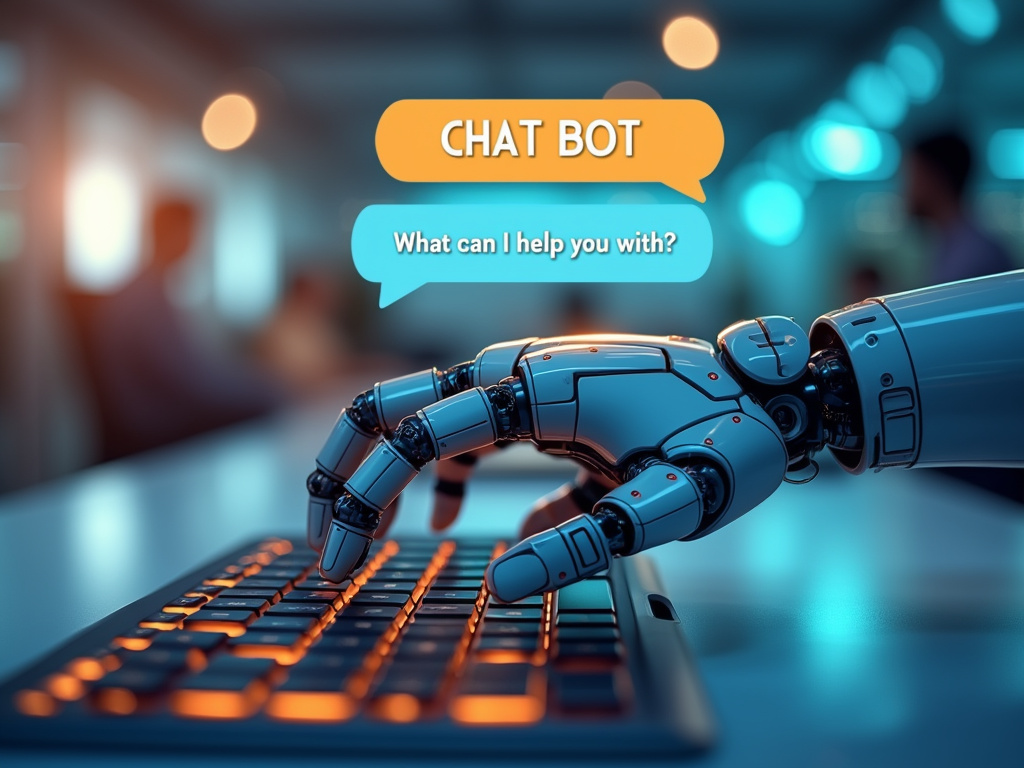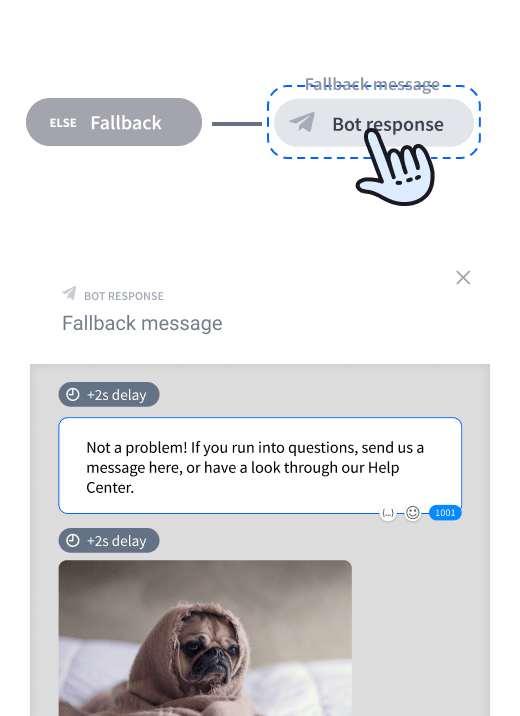Businesses are turning to an unlikely ally to enhance customer experience: chatbots. These AI-powered digital assistants are transforming how companies interact with their customers, offering a blend of efficiency, personalization, and round-the-clock support that was once unimaginable.
Imagine a world where your burning questions are answered instantly, at any hour of the day or night. Where personalized product recommendations appear as if by magic, and complex queries are seamlessly routed to the right human expert. This isn’t science fiction – it’s the reality that chatbots are creating in customer service departments across the globe.
But what exactly makes chatbots such game-changers in the realm of customer experience? Let’s dive into the myriad ways these digital helpers are reshaping customer interactions:
- 24/7 Availability: Chatbots never sleep, providing instant responses even when your human team is off the clock.
- Efficiency Boost: By handling routine queries, chatbots free up human agents to tackle more complex issues.
- Personalization at Scale: AI-powered chatbots can analyze customer data to offer tailored recommendations and solutions.
- Multilingual Support: Language barriers dissolve as chatbots converse fluently in multiple tongues.
- Reduced Wait Times: Say goodbye to frustrating queues – chatbots can handle multiple conversations simultaneously.
We will explore the intersection of chatbots and customer experience, unpack these benefits in detail, examine real-world success stories, and address the challenges that come with this technological shift. Join us on a journey through the exciting world of AI-enhanced customer service.
How Chatbots Increase Efficiency
Imagine a customer service team that never sleeps, responds instantly, and handles hundreds of inquiries simultaneously. That is the power of chatbots. These AI-powered assistants are transforming customer interactions, boosting efficiency, and reshaping how businesses operate.
Chatbots automate routine inquiries, freeing up human agents to tackle more complex challenges. Need to check an order status? A chatbot can pull that information in seconds. Wondering about store hours? The bot has you covered. This automation is a game-changer for operational efficiency.
By handling these repetitive tasks, chatbots significantly reduce the workload on human agents. This shift allows your team to focus on high-value interactions that require a human touch. The result? A more engaged and productive workforce, tackling the issues that matter most to your customers and your bottom line.
The efficiency gains extend beyond just task management. Chatbots slash response times, often providing instant answers where customers might have waited minutes or even hours for human assistance. This speed is transformative for customer satisfaction. Chatbots deliver the rapid service modern consumers crave.
Chatbots can reduce customer service costs by up to 30% while handling four times as many customer interactions as human agents.
Let’s talk numbers. The cost savings associated with chatbot implementation can be substantial. By automating a significant portion of customer interactions, businesses can optimize their resources and reduce operational expenses. It is not about replacing humans—it is about empowering them to work smarter, not harder.
Efficiency is not just about speed and cost—it is about enhancing the overall customer experience. Chatbots provide consistent, accurate information around the clock. No more frustration with conflicting answers or limited service hours. This reliability builds trust and satisfaction, turning casual customers into loyal advocates for your brand.
As AI technology advances, the capabilities of chatbots continue to expand. Today’s chatbots can handle increasingly complex queries, learn from interactions, and even anticipate customer needs. This ongoing evolution promises even greater efficiency gains in the future, making chatbots an essential tool for forward-thinking businesses.
The efficiency revolution driven by chatbots is not just changing how businesses operate—it is reshaping customer expectations. In a world where instant gratification is the norm, chatbots deliver the speed, accuracy, and convenience that modern consumers demand. By embracing this technology, businesses are not just keeping up—they are setting new standards for customer service excellence.
Personalized Interactions with Chatbots

Imagine a friendly digital assistant that remembers your name, knows your preferences, and anticipates your needs. That’s the power of personalized chatbot interactions. By harnessing customer data and cutting-edge AI, chatbots are transforming how businesses connect with their audience.
These AI-powered helpers analyze a wealth of information—from past purchases to browsing habits—to craft responses tailored just for you. It’s like having a super-attentive salesperson who never forgets a detail about your tastes.
Take Sephora’s Virtual Artist chatbot, for example. This savvy bot doesn’t just recommend random beauty products. It studies your skin tone, previous buys, and even the season to suggest makeup that’s perfect for you. The result? Customers feel understood and valued, not just another face in the crowd.
Or consider Starbucks’ mobile app chatbot. It remembers your go-to latte order and even suggests new drinks based on your flavor preferences. On a hot day, it might tempt you with a refreshing iced version of your favorite brew. This level of personalization makes customers feel like the app knows them as well as their local barista.
Bank of America’s Erica takes personalization to the next level in finance. This AI assistant doesn’t just recite your account balance. It analyzes your spending patterns and offers tailored advice to help you reach your financial goals. Erica might gently remind you that you’re overspending on dining out this month, based on your usual habits.
The Science Behind Personalized Chatbots
So how do these chatbots get so smart? It’s all thanks to advanced technologies like machine learning and natural language processing. These AI tools allow bots to understand context, learn from each interaction, and improve their responses over time.
Machine learning algorithms sift through mountains of data to spot patterns in customer behavior. They can predict what a user might need next, often before the customer realizes it themselves. Natural language processing, on the other hand, helps bots understand the nuances of human communication, picking up on tone and intent.
The result is a chatbot that feels less like a robot and more like a helpful friend. It can crack jokes, offer sympathy, or provide encouragement—all while delivering the information or service the customer needs.
Building Stronger Bonds
This personal touch isn’t just about making customers feel good (though that’s certainly important). It’s a powerful tool for building lasting loyalty. When customers feel understood and valued, they’re more likely to stick with a brand long-term.
Personalized chatbots create a virtuous cycle. The more a customer interacts with the bot, the better it understands their needs. This leads to even more satisfying interactions, deepening the customer’s connection to the brand.
When we implemented a Florida-climate-savvy chatbot that could explain how humidity affects AC units and recommend appropriate maintenance schedules, we saw a 25% increase in scheduled service appointments compared to our previous generic system. The personality difference was crucial—customers responded more positively to a chatbot that understood their specific regional concerns rather than providing generic HVAC advice.
– Christy Robinson, Director of Marketing, Comfort Temp
For businesses, the benefits are clear. Higher customer satisfaction, increased engagement, and ultimately, a boost to the bottom line. It’s no wonder that companies across industries are investing in smarter, more personalized chatbot experiences.
As AI technology continues to advance, we can expect even more impressive feats of personalization. The future of customer service isn’t just automated—it’s intimately tailored to each individual user. Welcome to the era of chatbots that truly get you.
24/7 Availability of Chatbots
Customer expectations have skyrocketed. Gone are the days when businesses could close at 5 PM. Enter chatbots—a tireless digital workforce that is transforming customer support. Chatbots provide round-the-clock availability, which is a game-changer for businesses operating globally. Whether it’s 3 AM on a Tuesday or noon on a Sunday, these AI-powered assistants are ready to provide immediate assistance. This constant accessibility is no longer a luxury; it has become a necessity in our interconnected world.
Imagine a potential customer in Tokyo browsing your US-based website at midnight EST. With a chatbot, that crucial inquiry doesn’t have to wait until your human agents return to work. The chatbot can instantly engage with the customer, answer questions, and even guide them through a purchase—all while your team sleeps soundly.
However, it’s not just about being available; it’s about being consistently reliable. Unlike human agents who may tire or have off days, chatbots maintain a steady level of service quality 24/7. They don’t need coffee breaks, never get cranky after hours of repetitive queries, and don’t call in sick. The benefits of this constant availability go beyond customer satisfaction; they can significantly impact your bottom line. A study by IBM found that businesses can save up to 30% on customer support costs by implementing chatbots. Furthermore, the ability to engage customers instantly can lead to higher conversion rates and increased sales.
The future of customer service is here, and it never sleeps. However, it’s important to note that chatbots aren’t meant to completely replace human agents. Instead, they complement human efforts by handling routine queries, allowing your team to focus on more complex issues that require a personal touch. This symbiotic relationship between AI and human agents creates a robust support system that can handle any customer need at any time.
As we progress further into the digital age, the importance of 24/7 availability will only grow. Businesses that leverage chatbots to provide round-the-clock service will find themselves at a significant advantage, better equipped to meet the ever-evolving expectations of the global market. The 24/7 availability of chatbots is not just a feature—it’s a powerful tool that can elevate your customer service from good to exceptional. By embracing this technology, you’re not just keeping up with the times; you’re staying ahead of the curve, ensuring that your business is always there when your customers need you.
Addressing Chatbot Miscommunications

Need help? Contact support or visit the Help Center. – Via chatbot.com
We’ve all been there – trying to get help from a chatbot only to end up more frustrated than when we started. Despite impressive advances in AI, chatbots can still trip up when it comes to understanding what we really need. Let’s explore why these digital assistants sometimes miss the mark and what companies are doing to make chatbot conversations smoother.
Imagine messaging an airline’s chatbot to change your flight, but it keeps suggesting new bookings instead. Or trying to return a defective item, but the bot insists on troubleshooting steps for a product you don’t even own. These miscommunications waste time and test our patience. A 2023 study found that 68% of consumers reported feeling frustrated by chatbot interactions that failed to properly address their issues.
Why Do Chatbots Misunderstand?
Chatbots rely on natural language processing (NLP) to interpret human messages. But language is complex, full of nuance and context that can trip up AI. Ambiguous phrasing, typos, or industry-specific terms can all lead chatbots astray. For example, asking “When does my policy renew?” might work fine, but “When’s my insurance up?” could confuse a bot not trained on that specific phrasing.
Additionally, chatbots often struggle with context. They may not realize that your question about “coverage” relates to an earlier mention of car insurance rather than health insurance. This inability to maintain context throughout a conversation frequently leads to irrelevant or repetitive responses.
Optimizing for Accuracy
Companies are actively working to minimize these frustrating misunderstandings. Here are some key strategies:
- Continuous learning: Analyzing real conversations helps identify common misinterpretations and expand the chatbot’s knowledge base.
- Improved intent recognition: Advanced NLP techniques help chatbots better grasp the true meaning behind user messages.
- Contextual awareness: Developing chatbots that can maintain context throughout a conversation, leading to more relevant responses.
- Human oversight: Implementing systems where human agents can seamlessly take over complex inquiries the chatbot can’t handle.
Regular updates and fine-tuning are crucial. A well-maintained chatbot can significantly reduce errors over time. For instance, after implementing an optimization program, one major retailer saw a 40% decrease in chatbot-related customer complaints within three months.
The Future of Chatbot Communication
As AI technology evolves, we can expect even more sophisticated chatbots. Imagine assistants that can pick up on emotional cues or effortlessly handle multi-step requests. While we’re not quite there yet, the focus on optimization is steadily closing the gap between human and machine communication.
In the meantime, the next time a chatbot misunderstands you, remember – it’s probably learning from that interaction. Your frustration today might just lead to smoother conversations for everyone tomorrow.
The art of communication is the language of leadership. But when it comes to chatbots, sometimes it feels more like miscommunication is the language of madness.
James Humes, speechwriter and author
Have you had any particularly memorable (good or bad) experiences with chatbots? Share your stories in the comments – they might just help shape the future of AI customer service!
Case Study: Domino’s Pizza Ordering Chatbot
Domino’s Pizza has carved out a niche for itself with its innovative approach to customer service. The pizza giant’s implementation of a sophisticated ordering chatbot marks a significant leap forward in how customers interact with food delivery services.
Domino’s chatbot, affectionately dubbed ‘Dom’, isn’t just another automated system. It’s a virtual pizza concierge that has transformed the ordering process from a mundane task into a seamless, almost conversational experience. Customers can now place orders, track deliveries, and receive updates with the ease of chatting with a friend.
But what makes Dom truly special? It’s the bot’s ability to understand and process natural language, allowing customers to order their favorite pizzas using everyday speech or even emojis. This level of intuitive interaction has significantly reduced the friction in the ordering process, leading to a notable uptick in customer satisfaction.
Streamlined Ordering Process
Gone are the days of navigating complex menus or waiting on hold to speak with a representative. With Dom, customers can simply type or speak their order, and the chatbot takes care of the rest. This streamlined approach has dramatically cut down order processing times, allowing Domino’s to serve more customers more efficiently.
The impact on order processing times has been nothing short of remarkable. What once took several minutes now happens in a matter of seconds. This efficiency not only pleases customers but also allows Domino’s to handle higher order volumes without sacrificing quality or speed of service.
| Metric | Before Chatbot Implementation | After Chatbot Implementation |
|---|---|---|
| Average Order Processing Time | 7 minutes | 2 minutes |
| Order Accuracy Rate | 90% | 98% |
| Customer Satisfaction Score | 75% | 90% |
| Order Volume Capacity | 50 orders/hour | 200 orders/hour |
Enhanced Customer Experience
Dom’s capabilities extend beyond just taking orders. The chatbot can provide real-time updates on order status, estimated delivery times, and even offer personalized recommendations based on past orders. This level of engagement and personalization has created a more interactive and enjoyable ordering experience for customers.
The convenience factor cannot be overstated. Whether it’s a busy parent ordering dinner for the family or a group of friends planning a movie night, Dom makes the process quick, easy, and dare we say, fun. The ability to order from anywhere, at any time, without the need for human interaction, has been a game-changer for many Domino’s customers.
Measurable Impact on Customer Satisfaction
The implementation of the chatbot has led to a significant boost in customer satisfaction scores. Domino’s has reported a notable increase in positive feedback, with customers praising the speed, convenience, and reliability of the ordering process. This improved customer experience has translated into increased customer loyalty and repeat business.
Moreover, the chatbot has proven to be an excellent tool for gathering customer insights. Every interaction provides valuable data that Domino’s can use to further refine its services and tailor its offerings to customer preferences.
The success of our chatbot goes beyond just taking orders. It’s about creating a more engaging, personalized experience for our customers. Dom has become an integral part of our brand identity.
Mandi Galluch, Domino’s Program Leader for Digital Experience
As Domino’s continues to refine and expand the capabilities of its chatbot, it sets a new standard for customer service in the food delivery industry. The success of Dom demonstrates that when technology is leveraged thoughtfully, it can create significant value for both businesses and customers alike.
In an age where convenience and speed are paramount, Domino’s Pizza’s ordering chatbot stands as a shining example of how artificial intelligence can be harnessed to enhance the customer experience. It’s not just about delivering pizzas anymore; it’s about delivering satisfaction, one chat at a time.
Conclusion: Future of Chatbots in Customer Experience
Chatbots are revolutionizing customer engagement by delivering heightened efficiency, tailored interactions, and round-the-clock availability. Businesses across industries are witnessing transformative results in how they connect with and serve their customers.
The future of chatbot technology is promising. As artificial intelligence advances, we can expect chatbots to become more sophisticated, understanding context and nuance and even predicting customer needs. This will create deeply personalized, empathetic, and proactive customer experiences.
Platforms like SmythOS are leading the charge in this rapidly advancing field. By offering a strong foundation for chatbot development and deployment, SmythOS empowers businesses to seamlessly integrate these AI-driven tools into their infrastructures. The platform supports autonomous operations, allowing chatbots to learn, adapt, and improve without constant human intervention.
Chatbots are not a fleeting trend but a fundamental shift in how businesses approach customer experience. The future promises more natural, helpful, and aligned interactions with individual customer needs. Forward-thinking companies must embrace this technology to stay competitive and deliver the exceptional experiences that modern customers demand.
The revolution in customer experience is here, driven by chatbots. Businesses that harness the power of AI-driven customer engagement will thrive in the digital age. The question is not whether chatbots will transform customer experience but how quickly and effectively businesses will adapt to this new reality.
